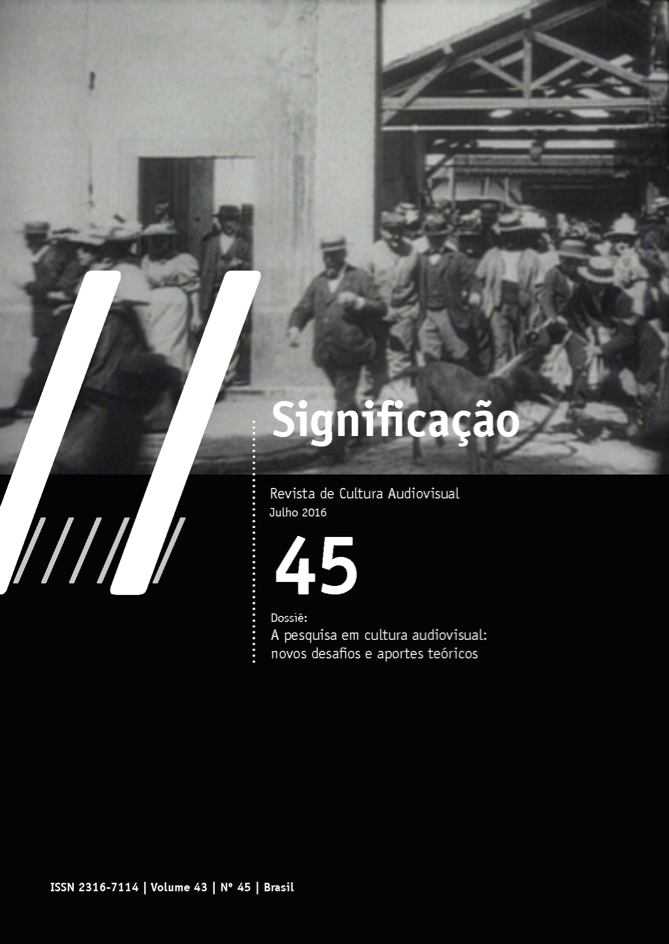Rock, apathy and violence
DOI:
https://doi.org/10.11606/issn.2316-7114.sig.2016.103444Keywords:
Rodrigo D, ¿Cómo ves?, marginalized youth, free indirect subjectiveAbstract
Rodrigo D. No futuro and ¿Cómo ves? will be analyzed in this paper. These films address a recurring theme in the cinema of Latin America: the marginalized youth. In the 1980s and the 1990s, with the advance of neoliberalism and the crisis of left-wing projects, the subject gained new forms of representation. Critics pointed out that these films seem to be situated far from the modern cinema aesthetics. In our analysis, we will establish a dialogue with such critics. These works take music as a link with the young audience and try to approach the inner life of its characters through the use of "free indirect subjective".Downloads
References
AGUILAR, G. Otros mundos. Buenos Aires: Santiago Arcos, 2010.
___. Más allá del pueblo. Buenos Aires: FCE, 2015.
AGUILAR, G e D. OUBIÑA. “La educación sentimental”. In. COSTANTINI, E. F. e CANGI, A. (orgs.). Favio - sinfonía de un sentimiento. Buenos Aires: MALBA, 2007, p. 57-72.
AUMONT, J. Moderno? Por que o cinema se tornou a mais singular das artes. Campinas: Papirus, 2008.
BAZIN, A. “Due soldi di speranza”. In. O que é o cinema? São Paulo: Cosac Naify, 2014, p. 327-348.
___. “Luis Buñuel” In. O cinema da crueldade. São Paulo: Martins Fontes, 1989, p. 47-94.
BIRRI, F. Por un nuevo nuevo cine latinoamericano. Madrid: Cátedra, 1996.
BRITTO G., L. El imperio contracultural del rock a la postmodernidad. La Habana: Editorial Arte y Literatura, 2005.
CANDIDO, A. “Nova narrativa”. In. A educação pela noite e outros ensaios. São Paulo: Ática, 1989, p. 199-215.
CROS, E. “De Piero della Francesca a Los olvidados”. In. LILLO, G. (org.). Buñuel, el imaginario transcultural. Ottawa: University of Ottawa/Legas, 2003, p. 21-32.
CUNHA, R. B. Transculturação narrativa: seu percurso na obra crítica de Angel Rama. São Paulo: Humanitas, 2007.
ECHÁVEZ M., V. “Agarrando pueblo, a arte de sugar o sangue da miséria”. In. Revista Movimento, nº2, dez. 2012. Disponível em: https://docs.google.com/file/d/0B6-MEbjz_JTzSnZfVllpelJZZ3c/edit Acesso em 7 set. 2015.
FRANCIA, A. El Nuevo Cine Latinoamericano en Viña del Mar. Santiago de Chile: Cesoc, 1990.
GARCÍA Borrero, J.A. La edad de la herejía. Santiago de Cuba: Editorial Oriente, 2002.
GETINO, O. e S. VELLEGGIA. El cine de las historias de la revolución. Buenos Aires: Altamira, 2002.
GRÜNER, E. “El retorno de la teoría crítica de la cultura: una introducción alegórica a Jameson y Zizek”. In. GRÜNER, E. (org.). Estudios culturales – reflexiones sobre el multiculturalismo. Buenos Aires: Paidós, 2008, p. 11-67.
JIMÉNEZ, J. “Crónicas de la disidencia – contracultura y globalización en América Latina”. In. Revista de Filosofía de la Universidad de Costa Rica, XXXV/86, 1997, p. 169-183.
LEÓN, C. El cine de la marginalidad – realismo sucio y violencia urbana. Quito: Abya-Yala, 2005.
MAYOLO, C. e L. OSPINA. “Qué es la porno-miseria?”. Disponível em: http://tierraentrance.miradas.net/2012/10/ensayos/que-es-la-porno-miseria.html Acesso em 20 out. 2015.
PASOLINI, P.P. “El ‘cine de poesía’”. In. El cine como semiología de la realidad. México D.F.: UNAM/CUEC, 2006, p. 9-30.
ROCHA, G. “Torres Miguel”. In. Revolução do cinema novo. São Paulo: Cosac Naify, 2004, p. 53-59.
RICHARD, N. “Alteridad y descentramiento culturales”. In. Revista chilena de literatura, nº42, ago. 1993, p. 209-215.
RUFFINELLI, J. Victor Gaviria – los márgenes al centro. Madrid: Turner, 2004.
SANJINÉS, J. Teoría y práctica de un cine junto al pueblo. México D.F.: Siglo XXI, 1979.
SOBERÓN, E. Crítica a ¿Cómo ves?. In. Cine Cubano, nº126. Disponível em: http://paulleduc.net/ Acesso em 20 out. 2015.
XAVIER, I. Alegorias do subdesenvolvimento. São Paulo: Cosac Naify, 2012.
___. “O cinema moderno segundo Pasolini”. In. Revista de Italianística, São Paulo, ano I, nº1, 1993, p. 101-109.
___. “A alegoria histórica”. In. RAMOS, F. P. (org.). Teoria contemporânea do cinema - vol I. São Paulo: SENAC, 2005, p. 339-379.
Downloads
Published
Issue
Section
License
Copyright (c) 2016 Maria Alzuguir Gutierrez

This work is licensed under a Creative Commons Attribution-NonCommercial 4.0 International License.
Authors who publish in this journal must agree with the following terms:
- Authors keep their copyrights and grant the journal first time publication rights, having their articles simultaneously licensed under the Creative Commons Attribution License, which allows sharing texts with authorship recognition and first publication on this journal for non-commercial purposes.
- Authors are allowed to make additional contracts, for a non-exclusive distribution of the article’s version published on this journal (e.g.: publishing in institutional repositories of articles or as a book chapter), with authorship recognition and first publication on this journal.
















